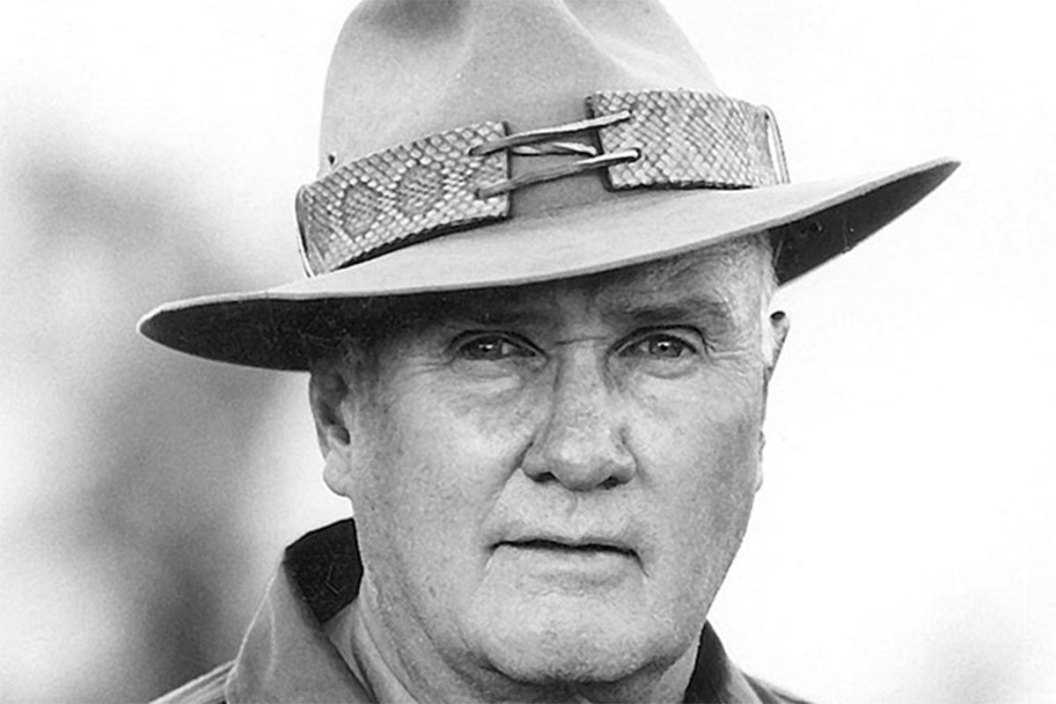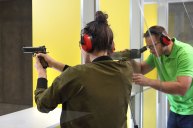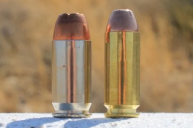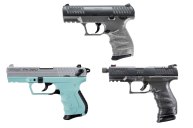Here's how a Marine who fought in World War II and Korea changed the way people shoot handguns forever.
The man who would be known as Col. Jeff Cooper and change a whole lot about the way people used firearms was born John Dean Cooper on May 10, 1920 in Los Angeles, California.
In high school, he enrolled in the Junior Reserve Officer's Training Corps. Later, he graduated from Stanford University with a bachelor's degree in political science.
When the Second World War rolled around, Cooper received a regular commission in the United States Marine Corps in September 1941. During the war, he fought in the Pacific with the Marine Detachment aboard the USS Pennsylvania. He survived the war, rising to the rank of major by its end.
He left the Corps in 1949, but returned to active duty during the Korean War, during which he conducted "irregular warfare" operations and was promoted to the range of Lieutenant Colonel. Cooper wanted to remain on active duty after the war, but the Marines declined his application.
A Focus on Education and Training
Since his time in the Marines appeared to be at an end, Cooper turned back to his education, receiving a master's degree in history from the University of California, Riverside in the 1960s. He also worked as a part-time high school history teacher and community college teacher from the 50s through the 70s. Imagine having Jeff Cooper, eventual gun trainer extraordinaire, randomly subbing for your 10th grade history class...
In 1976, Cooper through himself into what would become a prolific shooting career when he founded the American Pistol Institute (API) in Paulden, Arizona to provide firearms training. Today, API is better known by its new name: Gunsite Academy.
At API, Cooper taught small arms classes, including pistol courses and marksmanship for law enforcement and military personnel and civilians, and provided training for people and groups from around the world.
Cooper sold API in 1992, but continued living at his nearby ranch.
Cooper was also the founding president an Honorary Lifetime Chairman of the International Practical Shooting Confederation (IPSC), though he was later critical of the direction the organization took regarding focusing on highly modified competition guns rather than practical firearms.
The Modern Technique of the Pistol
One of the most lasting legacies of Jeff Cooper is his most famous invention: "The Modern Technique of the Pistol." It is a set of elements and practices that, when combined, produce a system for using a handgun for self defense with better effectiveness than any previous training method.
Most elements of Cooper's system, which he introduced in the 1950s, are still taught today, though bits and pieces have been updated or supplanted with newer ideas.
The primary emphasis of Cooper's modern technique for personal defense includes using a two-handed grip and using the Weaver stance. Before Cooper, one-handed pistol shooting, usually from a bladed stance, was prevalent in target shooting and defensive shooting alike, and point shooting, where the sights aren't used at all, was also widely taught.
The Weaver stance, developed by Jack Weaver, is basically the same stance a person would take to throw a punch, keeping them balanced with the off-side foot forward, knee slightly bent. The pistol is held by both hands with the shooting hand pushing and the support hand pulling, creating dynamic tension to steady the handgun and control recoil as it is brought to eye level so the sights can be utilized. The shoulders should be leaning forward so they break the plane of the off-hand toe.
Today, the isosceles or modified Weaver stance have become more popular, but generally, people are taught to use whatever stance is most comfortable and results in the best accuracy.
Cooper's method was finally put into book form in 1991 with "The Modern Technique of the Pistol" by Gregory B. Morrison and Cooper.
There are four central elements of the modern technique: an appropriately powerful pistol, plus an effective way to hold it, aim it, and fire it. He used three Latin words to summarize these self defense ideas:
- Diligentia (Accuracy): you must hit an assailant in order to injure them
- Vis (Force): You must strike your opponent with sufficient force to incapacitate them.
- Celeritas (Speed): You must strike quickly, so your opponent does not injure you before you injure them.
This resulted in Cooper's personal motto being expressed as "DVC." The short and dirty way to remember the main tenets of the modern technique is "front sight/press."
The Elements of the Method, Spelled Out
Use of a Large-Caliber, Semi-Auto Pistol is Preferable.
Cooper was a big fan of the 1911 and its .45 ACP ammo. His logic behind this was fairly simple. Semi-auto handguns allow for continuous defensive fire if necessary, as they are much easier and faster to reload than a revolver, even in low light and with little training.
Back when he was fighting in the Pacific Theater in World War II, Cooper followed the advice of famous gunfighter Charles Askins and carried a Colt Single Action Army revolver into combat instead of an M1911A1 and later said doing so nearly got him killed.
The large-caliber part is because Cooper believed it was important to do as much damage to an attacker as possible, as fast as possible, so as to incapacitate them before they can do any harm, and that larger caliber bullets did this more effectively than smaller caliber bullets.
For him, this meant the largest caliber possible that was still controllable in handgun shooting, which he deemed to be the .45 ACP. For people of smaller stature, he recommended the most powerful round they could comfortably shoot well.
Cooper was a big believer in stopping power, a term that has become controversial over the years, as many believe the concept is flawed or outright nonexistent, and that shot placement is more important. This can be seen in the general shift of law enforcement agencies and militaries away from .45 ACP and .40 S&W pistols in favor of a 9mm Luger chambering in conjunction with modern defensive ammunition.
The U.S. military has had a 9mm pistol as standard issue since 1986, though some special ops still prefer a .45 ACP.
The Weaver Stance
The idea of using two hands when gripping a pistol was a huge improvement over the one-handed shooting method previously taught for ages, and allowed for better use of a pistol's sights. That resulting in iron sights on handguns being developed that are much more significant, better engineered, and easier to see.
The Flash Sight Picture
The flash sight picture is a way of aiming a handgun that falls between point shooting, where the sights aren't used at all, and the deliberate, and slow, alignment of the sights as one would when slow-firing at a paper target.
The idea is to get a sight picture, and not a perfect sight picture, but some sight picture as fast as possible before squeezing the trigger. This will result in a shot that may not be perfectly aimed, but will hit its target with greater reliability and with less training than point shooting, and yet still much faster than deliberate aiming.
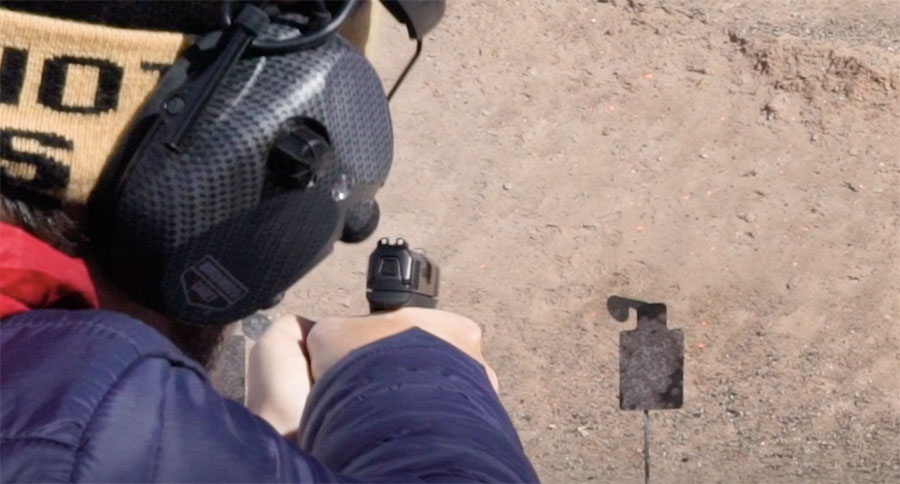
The human eye cannot focus on the rear sight, the front sight, and the target all at once, so Cooper taught shooters to focus on the front sight of the pistol only and align it with the target, while using the rear sight peripherally.
Focusing on the front sight became a huge part of the modern method. This tenet has also been aided by the development of better handgun sights over the years.
Compressed Surprise Trigger Break
This is fairly self explanatory. Cooper believed in a surprise break of the trigger, meaning the shooter should squeeze steadily and be slightly surprised when the trigger fires the pistol.
The way he described it was the shooter should pull the trigger as if it were a glass rod that breaks with every shot. The surprise is so the pistol remains aligned with the target while the muscles of the hand go from gripping to also squeezing the trigger. If a trigger is squeezed more gradually, the alignment shifts less as the hand muscles engage and torque the pistol.
Firearm Conditions of Readiness
As Cooper's preferred pistol was the M1911 and similarly designed pistols, he developed a system to describe the various conditions of readiness in which a single-action semi-auto pistol with a thumb safety can be carried. They are:
- Condition 4: Chamber empty, empty magazine, hammer down.
- Condition 3: Chamber empty, full magazine in place, hammer down.
- Condition 2: A round chambered, full magazine in place, hammer down.
- Condition 1: A round chambered, full magazine in place, hammer cocked, safety on.
- Condition 0: A round chambered, full magazine in place, hammer cocked, safety off.
Condition 0 is considered "Ready to fire" and as a result, there is a risk of accidental or negligent discharge carrying in Condition 0. The 1911 was designed to be carried in Condition 1.
Cooper's Conditions of Readiness Color Code
As part of the modern technique, Cooper emphasized readiness and developed a system to codify conditions of personal readiness to encounter danger.
- White - Not Aware: This is when a person is completely unaware of their surroundings or what's happening in them. Examples: sleeping, reading a book, etc. with little to no perception of their environment or movements therein.
- Yellow - Aware, but Unspecific: A person is aware of their surroundings and monitoring what is happening in those surroundings.
- Orange - Specific Alert: A person is aware of any activity or other person within their surroundings which presents a threat.
- Red - Facing Danger: This is when a person is in fight mode (although not necessarily shooting yet). The individual is aware of a specific immediate threat, which will likely result in the use of deadly force.
Cooper's Color Code of Readiness was eventually adopted by the U.S. Marine Corps.
These basics are the the surface-scratching elements of Cooper's overall impact on the way we shoot guns. Though debates still occur surrounding the efficacy or need to adjust any of Jeff Cooper's principles, there's no disputing his influence on the world of firearms and self defense.
To find Cooper's books on Amazon, check out this link.
NEXT: MOSSBERG 940 JM PRO COMPETITION SHOTGUN
WATCH
